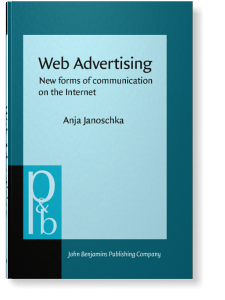Web Advertising
New forms of communication on the Internet
Author
Netlibrary e-Book – Not for resale
ISBN 9781423772392
This book examines new forms of communication that have emerged through the interactive capabilities of the Internet, in particular online advertising and web advertisements. It develops a new model of online communication, incorporating mass communication and interpersonal communication. Interactive mass communication redefines the roles of online communication partners who are confronted with a higher degree of complexity in terms of hypertextual information units. In web advertising, this new aspect of interactivity is linguistically reflected in different types of personal address forms, directives, and "trigger words". This study also analyzes the different strategies of persuasion with which web ads try to initiate their activation.
Web Advertising provides essential information on the language of web advertisements for academics, researchers and students in the fields of hypertext-linguistics, advertising, communication and media studies.
[Pragmatics & Beyond New Series, 131] 2004. xiv, 230 pp.
Publishing status: Available
© John Benjamins Publishing Company
Table of Contents
-
Acknowledgments
-
Table of figures
-
1. Introduction | pp. 1–8
-
2. Traditional Advertising | pp. 9–41
-
3. Online Advertising | pp. 43–81
-
4. Communication | pp. 83–120
-
5. The language of web ads | pp. 121–158
-
6. Hyperadvertising | pp. 159–190
-
7. Summary and Conclusion | pp. 191–199
-
Notes | pp. 201–209
-
-
Index | pp. 223–227
“Janoschka's book takes us on a journey into the net culture and helps us understand the structure and organization of this new form of advertising.”
Robert N. St. Clair, in Language Problems & Language Planning Vol. 30:2
“
Web Advertising narrowly defines its purpose and goes deeper than the latest craze; providing principles upon which scholars and professionals can build.”
Sharee L. Broussard, MS APR, Spring Hill College, in Communication Research Trends Vol. 25:1 (2006)
“This book has many merits. It offers a useful tool of analysis of textuality on the Web. Even though it focuses on one type of texts only, web ads, by a contrastive and similarity approach it makes useful connections with other types of textuality, both traditional, e.g. printed, and non-traditional, such as emails or chats.”
Marina Santini, University of Brighton, UK, on Linguist List, Vol. 16.1652 (2005)
Cited by (37)
Cited by 37 other publications
Rabindranath, Manukonda & Aradhana Kumari Singh
Sluchinski, Kerry
2023. Pronoun TA as a facilitator of empathy in Chinese digital narratives. Chinese Language and Discourse. An International and Interdisciplinary Journal 14:2 ► pp. 301 ff. 
AYDOĞAN, Hediye
Dayter, Daria & Thomas C. Messerli
2022. Persuasive language and features of formality on the r/ChangeMyView subreddit. Internet Pragmatics 5:1 ► pp. 165 ff. 
Khedri, Mohsen, Eatidal Hasan & Konstantinos Kritsis
Lazzeretti, Cecilia & Marina Bondi
2022. ‘A hypnotic viewing experience’. promotional features in the language of exhibition press announcements. Pragmatics. Quarterly Publication of the International Pragmatics Association (IPrA) ► pp. 567 ff. 
Pérez Blanco, María & Marlén Izquierdo
Kurchenkova, Elena A., Irina V. Palashevskaya & Viktor V. Leontiev
Majeed, Mohammed Fareed
Schudy, Fabian
Federspiel, Esther, Anja Janoschka & Seraina Mohr
KAZAN, Hüseyin
Pelclová, Jana
2018. Chapter 12. Iconicity in independent noun phrases in print advertising. In Persuasion in Public Discourse [Discourse Approaches to Politics, Society and Culture, 79], ► pp. 281 ff. 
Siegert, Gabriele & Dieter Brecheis
Siegert, Gabriele & Dieter Brecheis
Auer, Peter
2017. Chapter 14. Epilogue. In Imperative Turns at Talk [Studies in Language and Social Interaction, 30], ► pp. 411 ff. 
Anusha
Eraslan, Sukru, Yeliz Yesilada & Simon Harper
Eraslan, Sukru, Yeliz Yesilada & Simon Harper
Lazzeretti, Cecilia
Valentina, Florea Nicoleta & Tanasescu Irina Antoaneta
Van Looy, Amy
Yang, Yifan
Stoian, Claudia Elena
Domański, Tomasz & Michał Sędkowski
Domański, Tomasz & Michał Sędkowski
Dessì, Silvia, Claudia Melis & Ernestina Giudici
Jakab, Radomír
Jessen, Iben Bredahl & Nicolai Jørgensgaard Graakjaer
Jessen, Iben Bredahl & Nicolai Jørgensgaard Graakjær
Mahmoud, Abd El-Basit, Paul Klimsa & Philip J Auter
Siegert, Gabriele
Guidère, Mathieu
Janoschka, Anja
Janoschka, Anja
[no author supplied]
This list is based on CrossRef data as of 18 july 2024. Please note that it may not be complete. Sources presented here have been supplied by the respective publishers. Any errors therein should be reported to them.
Subjects
Communication Studies
Linguistics
Main BIC Subject
CF: Linguistics
Main BISAC Subject
LAN009000: LANGUAGE ARTS & DISCIPLINES / Linguistics / General
